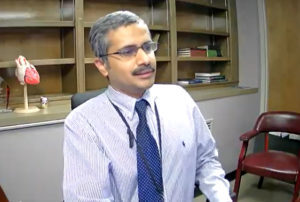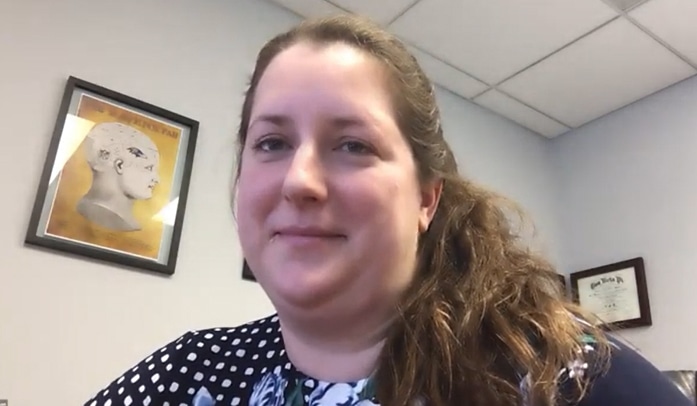Latest Virtual Showcase of Medical Discoveries Focuses on Cardiovascular Research
| Efforts to better understand heart problems and improve methods of detection and outcomes were the focus of the University of Arkansas for Medical Sciences (UAMS) most recent Showcase of Medical Discoveries, this time focused on cardiovascular research.
The virtual event, held April 21, was the 30th showcase sponsored by the UAMS Division of Research and Innovation. It included presentations of 20 collaborative research projects by UAMS researchers.
The goal of the series is to foster communication and collaboration between investigators and increase awareness of exciting research ideas.
While all the projects focus on the heart, they cover subjects ranging from new issues such as a late complication of COVID-19 to longstanding concerns about the damaging effects of steroids on the musculoskeletal system and the heart.
“One of the aspects of the cardiovascular field that I have always appreciated is how we translate discovery research into scientifically-based advancements and have harnessed the power of the scientific method to reduce death from cardiovascular disease and improve health,” said Susan Smyth, M.D., Ph. D., who will join UAMS in June as executive vice chancellor and dean of the College of Medicine, as she opened the event.
Smyth, a nationally known cardiologist and translational scientist, told the presenters, “You truly embrace the spirit of academic medicine to develop innovative strategies to address unmet health needs. I look forward to working with you all to leverage the strengths of UAMS across all missions of clinical care, education, research and service to improve health in Arkansas.”
Smyth is succeeding Christopher Westfall, M.D., who retires Aug. 1, 2021, after 24 years at UAMS.
The showcased projects focused on patients from infancy to old age.
One, presented by Tara Johnson, M.D., an assistant professor of pediatric neurology, is part of a larger study that aims to implement a new way to identify early signs of neurodevelopmental disabilities in children with single-ventricle physiology, a form of congenital heart disease. Children with single-ventricle physiology (SVP) are at high risk of developing those disabilities, which include developmental delay, autism and ADHD.
Johnson said that for a year, a team of eight researchers studied 10 infants with SVP who all had typical language development, gross motor delay and hyptonia, also referred to as “floppy baby.” The research team will track the neurodevelopment of each participant as they mature, in an effort to identify problems early and allow the subjects access to proven treatments and therapies.
In addition to Johnson, the team includes Lawrence Greiten, M.D.; Brian Reemtsen, M.D.; Dala Zakaria,M.D.; Heather G. Raiees-Dana, BSN, RN, CPN; Kenneth Knecht, M.D.; and students Alexa Escapita and Kelsey Renard Lambou.
Discussing research aimed primarily at helping people at the opposite end of the age spectrum was Jay K. Bhama, M.D., who has long been interested in the development of an extra-corpeal pulse-generating device that could save lives before patients get to the hospital.
“Patients with cardiac arrest are managed with chest compressions until they can be transported to a hospital where extra-corporeal mechanical circulation is available,” the UAMS heart surgeon said. “Among patients who survive transport, less than 10% survive to discharge due to organ damage during transport. There is a significant need for technology that would allow immediate restoration of circulation in the field.”
Bhama said an artificial cardiopulmonary support device that is easily transportable and could be used in the field would be a helpful advance in emergency medical care.
Current mechanical circulation devices can’t be used outside the hospital because they require the use of complicated equipment and specialized physicians. “Ultimately,” he said, “we envision this technology being highly portable for immediate field application in cardiac arrest patients.”
Researchers Edward T.H. Yeh, M.D., and Hui-Ming Chang, M.D., are trying to identify a new preventive strategy for Sudden Unexpected Death in Epilepsy (SUDEP), for which the causes aren’t well-understood and treatment options are limited.
Yeh, who is the director of UAMS’ Department of Internal Medicine in the College of Medicine, says SUDEP accounts for 1.16 deaths per every 1,000 people with epilepsy.
Amy Sato, Ph. D., a fellow studying physiology and cell biology at UAMS, discussed how glucocorticoid excess adversely affects the musculoskeletal system and heart. She said researchers that included Meloney Cregor, B.S.; David L. Halladay, B.S.; Munro Peacock, M.D.; Monte S. Willis, M.D., Ph.D.; and Teresita M. Bellido, Ph.D.; found that Vitamin D receptor activation blocks the upregulation of glucocorticoid-induced MuRF1, a protein, as well as tissue loss and dysfunction.
In the College of Pharmacy’s Division of Radiation Health, researchers Viji Mohan Seenivasan, Ph.D., MBA; Ashley Nemec-Bakk, Ph.D.; Kimberly Krager, Ph.D.; and Marjan Boerma, Ph.D.; are using animal models that mimic three scenarios of radiation exposure in an effort to determine biological mechanisms through which radiation has adverse effects in the heart. They are also testing potential intervention countermeasures.
“During radiation therapy of tumors in the chest of some patients, part of the heart may be exposed to radiation, which can have long-term effects on cardiovascular health,” their poster said. “Moreover, accidental radiation exposure can lead to cardiovascular disease, and there is a concern about potential adverse effects of ionizing radiation when astronauts travel in deep space.”

Srikanth Vallurupalli, M.D., discusses findings indicating that some patients with a form of cardiomyopathy show improvement.
Srikanth Vallurupalli, M.D., an associate professor in the Division of Cardiology, discussed imaging techniques and data to illustrate findings that some patients with cardiac amyloidosis, a form of cardiomyopathy that carries a poor prognosis, have defied conventional wisdom by showing structural and functional improvement.
Vallurupalli said it has always been believed that once cardiac structural abnormalities occur, they are irreversible. However, he said, UAMS’ multidisciplinary team of oncologists, cardiologists and radiologists who have developed expertise in the diagnosis and treatment of the condition are finding some evidence to the contrary by using state-of-the-art imaging techniques.
Jack Xu, M.D., a cardiology fellow, said research suggests clinicians should consider longer-term post-discharge efforts to prevent blood clots from forming in the veins of high-risk patients hospitalized with COVID-19 who have a low risk of bleeding.
He said a 36-year-old male patient with no significant medical history was admitted to the hospital after recovering from COVID-19 two months earlier, developing a stroke and completing a five-week course of apixaban. The man was found to have a non-occlusive filling defect of his left subclavian artery and improved after being started on apixaban and aspirin.
The origin of the subclavian thrombus was thought to be related to his COVID-19 infection.
“In combination with an inflammatory state and prolonged immobilization of critically ill COVID-19 patients, these mechanisms may be the etiology of arterial thrombo-embolisms,” he said.
Subodh Devabhaktuni, M.D., a cardiac electrophysiology specialist at UAMS, discussed a pilot project to evaluate the effectiveness of a 90-day, three-visit multidisciplinary strategy to manage patients with atrial fibrillation, the most common heart arrhythmia.
A team of specialists that will also include a psychologist, a dietician, a sleep medicine physician, an exercise physiologist and a pharmacist will use the UAMS telemedicine platform to follow 50 patients with symptoms that can negatively affect their quality of life to help them manage the symptoms through lifestyle and behavioral modification, in addition to medical management.
Other team members are Khaled Khasawneh, M.D.; Ming Hwei Yek, Psy. D.; Madeline Sorensen, Irion Pursell, MPH, RN; Samuel Sears, Ph.D.; Hakan Paydak, M.D.; and Paul Mounsey, M.D.
Other presentations included:
Cardiac Fibrosis Following Myocardial Ischemia is Mitigated by Mesenchymal Stem Cell Exosomes — Researchers: R.A. Kore, Xianwei Wang, Zufeng Ding, J.L. Mehta
Bleeding Cessation in a Mouse Jugular Vein Puncture Wound Model is Caused by Extravascular Capping, Not Hole Infill — Researcher: Brain Storrie
CardioWellness in Communities — Researchers: I. Pursell, S. Dugyala, Y. Ha, M. Sorensen, A. Terry and J. Mounsey
Recent Trends in Atrial Arrhythmia Hospitalizations and Procedure Utilization. Gender Differences in Catheter Ablation Utilization 2016-2018 — Researchers: Dinesh Vorunganti, Subodh Devabhaktuni, Hakan Paydak and Paul Mounsey
PCSK9 Regulates Cardiac Fibrosis in Chronic Myocardial Ischemia: Results of Preliminary Studies — Researchers: Zufeng Ding, Xianwei Wang, Rajshekhar A. Kore and Jawahar L Mehta
Genome-wide DNA Methylation Signatures Predict the Early Asymptomatic Doxorubin-induced Cardiotoxicity in Breast Cancer — Researchers: Michael J. Bauer, Valentina K. Todorova, Ping-Ching Hsu, Jeanne Wei, L. Joseph Su, Annjanette Stone, Weleetka Carter and Issam Makhoul
Machine Learning and Deformable Model-Based 4D Characterization of Cardiac Dyssynchrony from MRI — Researcher: Subhi Al Aref
Prospective Evaluation of the Strategy of Functionally Optimized Coronary Intervention — Researchers: Barry F. Uretsky, Shiv K. Agarwal, Srikanth Vallurupalli, Malek Al-Hawwas, Rimsha Hasan, Kristin Miller and Abdul Hakeem
Information and Platelets in Chronic Kidney Disease — Researchers: Nishank Jain, Adam Corken, John M. Arthur and Jerry Ware
Creating a No Power Auscultation Device for Remote Patient Monitoring — Researchers: Joseph Sanford, Kevin Sexton, Adria Abella Villafranca, Nikiya Simpson and Fuad Habash
Early Feasibility Study Aimed to Assess Safety and Performance of the Leaflex Performer in the Treatment of Symptomatic Severe Aortic Stenosis — Researchers: Guarav Dhar, Subhi Al’Aref, Srikanth Vallurupalli, Jay Bhama
The Sensitivity of Graphic Trends in Differentiating Sinus and Supraventricular Tachycardia — Researcher: Hakan Paydak
For more information, visit: https://research.uams.edu
